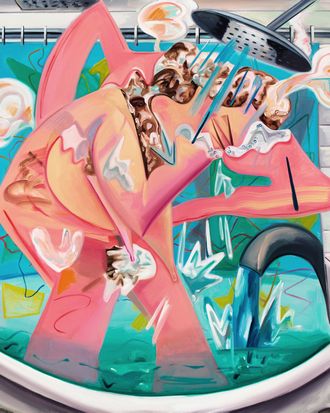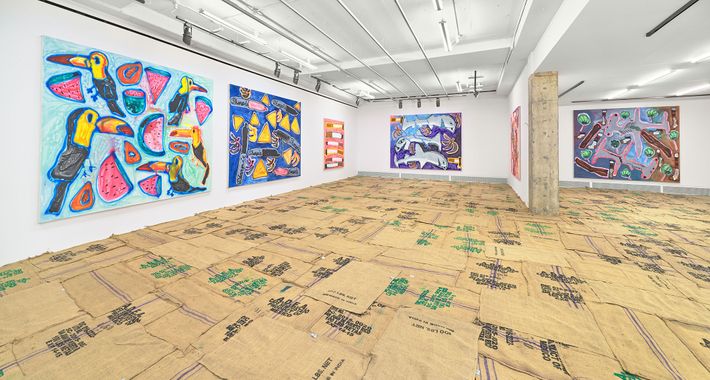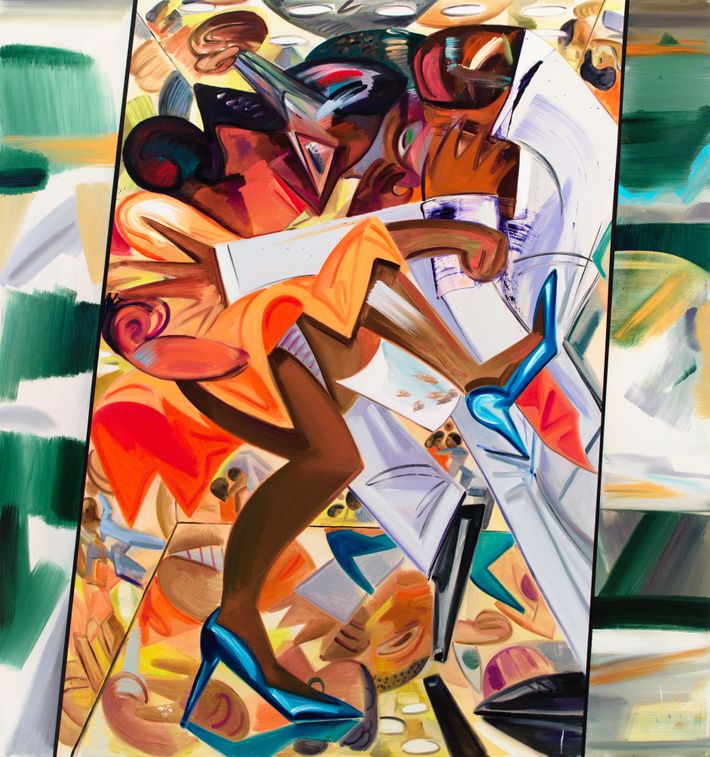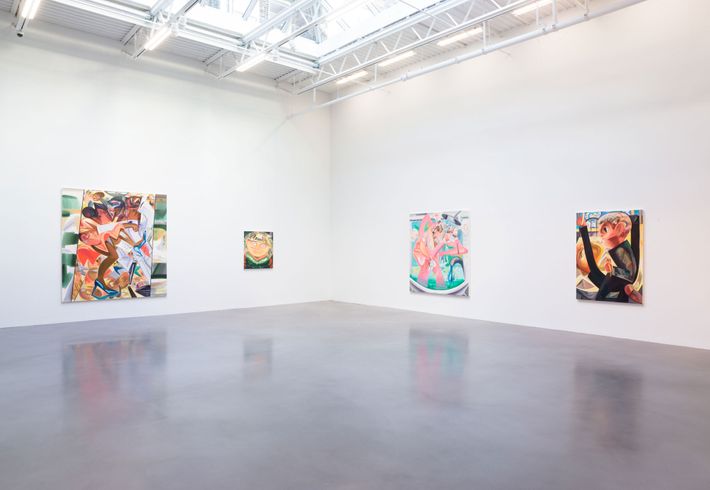
Dana Schutz and Katherine Bernhardt are among the liveliest American painters to emerge in this country in 15 years, and both opened big new shows over two nights a few weeks ago. Before we get to the exhibitions, a little history to help explain why the reputations of these two painters have careened so much over that time ÔÇö theyÔÇÖve been celebrated, passed over for big shows, and become dark horses, all while helping to shape the current charismatic painting moment.
Schutz and Bernhardt were born a year apart, in 1976 and 1975, respectively. Both hail from the Midwest ÔÇö Schutz from Livonia, Michigan, and Bernhardt from St. Louis. Both got their MFAs in New York: Schutz at Columbia, then approaching the height of hip; and Bernhardt at SVA, always an underdog school. Schutz had her much-noticed New York debut in 2002; Bernhardt had hers in 2000 ÔÇö although to almost no fanfare. In different ways, each has been instrumental in a transition that painting has made since then, from the more traditionally skillful, twisted figuration practiced in this country, especially by John Currin, Lisa Yuskavage, and Elizabeth Peyton, among others.

Perhaps more interestingly, they have also side-stepped many of the other micro-movements that have unfolded in painting since. Neither Schutz nor Bernhardt employs photographic tools, digital approaches, or outright appropriation in her work, in the manners of Peter Doig, Wilhelm Sasnal, and Luc Tuymans. ThereÔÇÖs no sign of the glitzy digital flatness of Takashi Murakami, or the never-ending European river of imitative post-Richter painters. Neither deals with reproductive issues in the veins of Wade Guyton or Kelly Walker. Nor has either of these artists gone down the super-popular, yawn-inducing ÔÇ£critique of paintingÔÇØ rabbit hole ÔÇö the perennial syllogistic ÔÇ£ItÔÇÖs paintings all the way downÔÇØ painting about painting about painting, and so on. I have in mind the many artists who cut holes in canvas or paint likenesses of cotton or linen weave, as if to say, This is a painted surface on painted painting of a painted surface that is a painting; or the many more good little postmodernists who make art-historical references or paint in known styles, so the message is something like, This is a nod to other works of art, which tells you that this painting knows itÔÇÖs ÔÇ£a paintingÔÇØ ÔǪ┬á put me in a biennial. This is a time in which art history has been simplified in order to be gentrified so that itÔÇÖs palatable to the widest market share, so anyone can look at a painting and say one of the magic names of Warhol, Richter, Kippenberger, Krebber, Koons, Guyton, or some preapproved artist or -ism. By now, not only could most of this work have been made anywhere anytime since 1945, much of it looks like itÔÇÖs from one small painting mill churning out collectibles. ItÔÇÖs as if artists, academics, curators, and critics are comfortable in a tractor beam of nostalgia that draws them forever back to some imagined wound in painting, a scab to peel back, and the same problems can forever be solved in similar ways. I imagine that when money goes away, so will this pious minutia of eternal return.
Contrary to these sentimental journeys, Schutz and Bernhardt have been endlessly idiosyncratic, always creating wide bandwidth variances of material, scale, surface, touch, tools, technique, color, and figuration. Schutz creates unsteady cornucopia compositions that build out of paint, creating shifting spatial planes that flip-flop, flickering in confetti color and, until recently, with creamy paint, which flower into bucolic clusterfucks. Hers is an everything-but-the-kitchen-sink approach to space. Bernhardt is much looser, her color more electric and intense, bordering on tropical fish that pool in psychedelic lagoons, thinning out, then building up in gluts that turn into brambly palimpsests and clammy reservoirs of iridescence. Her mode of composition is more organized than SchutzÔÇÖs, taxonomical in nature, with everyday images, like toilet paper, fashion models, and shoes, spray-painted, laid out as if found in a pop-culture specimen bed. Forget narrative around Bernhardt; a spitfire magpie, she follows WarholÔÇÖs credo of ÔÇ£liking things,ÔÇØ and paints what she likes the way she likes to paint it. At their worst, her latticeworks break down into wallpaper and place mats; at their best, they become rich visual tidal pools.

But while wildly admired among artists, neither has ever been in a Whitney Biennial or a Documenta, nor an Istanbul Biennial or any of those big international cattle-calls. (Schutz was included the vast 2003 Venice Biennale, among over 300 artists.) Nor was either included in last seasonÔÇÖs MoMA foray into contemporary painting, though they are the two names most often cited as artists whose work should have been included. Even if you think, Maybe their work is just crap, letÔÇÖs still see if we can look into the why of these rejections.
The short answer, IÔÇÖm afraid, amounts to something like a crime ÔÇö the crime of being a woman. Long careers of female bad-boy painters have always been rare ÔÇö in fact, there have been so few of them over the past 50 years that I can count them on one hand. And the art world has never really known what to do with them, mostly responding from fear. For 5,000 years, art has been almost the exclusive domain of men. As Linda Nochlin famously pointed out in 1971, for centuries women were excluded from even attending the academies, never able to learn the skill-sets and tools of painting, and were persona non grata among those who defined the status quo and controlled the flow of ideas and capital. Men were the geniuses and ordained shamans of art; women were the flesh that made muses move, or they were just witches. Or cast as regressive or crafty or corralled in erotic and girly ghettos. (Georgia OÔÇÖKeeffeÔÇÖs groundbreaking abstract paintings were derided as ÔÇ£great painful and ecstatic climaxes,ÔÇØ an ÔÇ£outpouring of sexual juices,ÔÇØ ÔÇ£loamy hungers of the flesh,ÔÇØ ÔÇ£the very essence of woman as Life Giver.ÔÇØ Clement Greenberg ridiculed her work as ÔÇ£little more than tinted photography.ÔÇØ Or imagine the discourse around the highly lauded blood paintings of Austrian actionist Herman Nitsch had his name been Helen.)
In this nightmarish way, almost all Western notions of beauty, form, technique, color, composition, subject matter, skill, surface, scale, and narrative have been shaped and controlled. Thankfully, over the last few decades women in the art world have rebelled, redefining painting again and againÔÇömeaning there are probably plenty of women whose names might spring to mind as examples of true path-breakers. But thereÔÇÖs still a significant restriction in place, one almost never mentioned. Very few of the female painters whoÔÇÖve won long-term careers have painted in expressionistic or more unleashed ways, deploying high-keyed color or ropy surfaces, or painting in ways that strike people as irrational, out of control, or non-cerebral. For a woman to paint in any way excessively, loudly, using thick paint or brash color, is a near taboo. (A great contemporary sculptor like Jessica Jackson Hutchins may currently be suffering some of the same prejudice.) Even more than a half-century after Abstract Expressionism, this kind of art is seen as male. When it comes to women painters, the art world is chroma-, gesture-, and effluvia-phobic. Unless ÔÇö and this is key ÔÇö the woman, say, Charline von Heyl or Jacqueline Humphries, both of whom deftly deploy gesture, color, and expression, is said to do so because she is doing so self-consciously, ÔÇ£using paintingÔÇÖs languagesÔÇØ cerebrally, with conceptual underpinnings and art-historical structure. (As if all art doesnÔÇÖt have varying degrees of these things.) By now this yearÔÇÖs republished Thames & HudsonÔÇÖs Abstract Expressionism only has two reproductions of paintings by women among its 172 pictures: Both are by Lee Krasner. Thus, these prohibitions and strictures filter into and infect the present. Whatever else she did, Schutz ÔÇö along with Nicole Eisenman ÔÇö was among the first women of late to cross these invisible lines. Indeed, when I wrote about SchutzÔÇÖs great 2002 debut, I speculated that her work was so wildly out there and unexpected that she had ÔÇ£an extra wrinkle on her frontal lobe.ÔÇØ

But that daring has made many people wary, especially when combined with the second factor: the market, and the way its fluctuations can transform the careers of even the most exciting and independent-minded artists. In this respect, you could call Schutz the Artist Zero of the ÔÇÿ00s art boom. She shot to overnight fame in 2002. Her first solo show in a small new gallery (LFL, now Zach Feuer), of different-size canvases of high-keyed, unfixed color, depicting collapsing scenes of noses exploding, faces fracturing, figures in combat, and lanky men with droopy dicks, sold out and were widely written about. A blast of air blew open a door in the House of Painting. People noticed. Artists first. Then collectors ÔÇö which is where the complications set in. Almost immediately, news spread of speculators buying and selling her work for huge figures. Soon her paintings were being sold at auction for almost a half-million dollars. At the same time, almost anyone whoÔÇÖd met Schutz claimed to have ÔÇ£discoveredÔÇØ her ÔÇö teachers, dealers, art advisers, everyone. It got to be a creepy joke. But a telling one. Something in the art world was splintering, and people sensed it.
What happened to Schutz happened fast. She is among the most open, honest artists anywhere (everyone adores her), and yet her fate over the next decade was, to my way of thinking, sad. The art world has a place for sensations, of course, but it offers a much more comfortable home if those sensations have dicks ÔÇö that is, if theyÔÇÖre men. See Nate Lowman, Urs Fischer, Joe Bradley, Mark Grotjahn, Dan Colen, Paul Chan, and many others who emerged about the same time. Schutz had a less happy fate; she was the canary in the market coal mine. While the optical power in her work, her wild imagery and color, even helped free artists who were her elders ÔÇö able painters like von Heyl, Humphries, Amy Sillman, and many others ÔÇö Schutz was cast as a ÔÇ£market artist,ÔÇØ somehow not part of the art community. (This happened to Cecily Brown as well.) Meanwhile, as these other artists deservedly gained more attention and ended up in important group shows and biennials, curators almost entirely bypassed Schutz for these sorts of exhibitions.
ThatÔÇÖs not the sad part, though. The sad part is the way the market backlash and prohibitions against wildness in women painters now seem to shadow what sheÔÇÖs actually doing. I love SchutzÔÇÖs work. Yet in her current exhibition ÔÇö her first since 2013, it is at Petzel gallery ÔÇö she seems overly self-conscious, tighter, caught between urges, alternately cartoonish and figurative but also more abstract and all-over. Few artists her age are as fearless when it comes to color; here, a profusion of citrus colors, Creamsicle orange, Lik-M-Ade yellows, violet, pear shades of green. Her shattered, multicolored, disjunctive compositional fields are rivaled only by elders like Peter Saul, Elizabeth Murray, David Salle, J├Ârg Immendorf, and James Rosenquist. She can seemingly master any space and scale. In the mural-size Shaking Out the Bed, figures, seen perhaps from the side, maybe lying down, reaching to the paintingÔÇÖs right side to the dials there to adjust perspectival vantage point, appear from above, slip into different pictorial spaces, or try to get outside the frame. ItÔÇÖs a kind of history painting unmoored and with no history. In two of the best works here ÔÇö Fight in an Elevator, which looks part Harlem Renaissance and part Who Framed Roger Rabbit, and the square-looking but not-square Slow Motion Shower ÔÇö Schutz forces two of paintingÔÇÖs major formal subplots to the fore. The first is how everything in any painting is always pressured, held in, defined, or in dialogue with the edges of frame. See the shower as an allegory of painting. A figure, letÔÇÖs say an artist, is held in and turning within the borders of the shower curtain ÔÇö a.k.a. the canvas. The figure is also bathing in liquidity ÔÇö a perfect metaphor for paint ÔÇö naked, in pleasure, but also abjectly covered in smudges, swiveling, scrubbing, identity blurred. Everything outside the tub, however, is black and white; maybe that way, for painters, reality becomes less real than the one theyÔÇÖre trying to render.

I think that the fracturing Cubo-Futurist construction and structure of these works, the ways sheÔÇÖs crossing the glittery temporal and planar shifts of Boccioni with Peter SaulÔÇÖs insane, all-over narratives in blazing acrid color, is an artist undertaking a remarkable painterly feat. There is a lot going on in every one of these works. However, except for a couple of canvases, IÔÇÖm not sure that thereÔÇÖs any one thing going on. This is a problem. (I would kill for any one of her drawings, however.) We are in awe of SchutzÔÇÖs immense skill at mustering frontal energy and painterly verve. Yet, as active as everything is, too many times I felt like I was mainly looking at parts. Never a whole. Too often the work tightened into something like a New Yorker cover illustration. I remember a great 2004 work of hers, another allegory of painting, a huge horizontal figure being dissected by doctor types amid a large number of onlooking heads. The picture was busy, but it was still so iconic that it tattoos itself permanently in the mind as an image. The work here is cartoony, crazy, exuding fabulously unfixed visual pheromones. But taste has changed around Schutz; painting has gotten more abstract. This at the same moment that SchutzÔÇÖs work has gotten more figurative, controlled, illustrative, and defined. Not in a good way. I miss the mushy subterranean rhythms and uncanny all-over abstractness of her work. This makes her current paintings feel somehow more isolated than before.
Which brings us to Katherine Bernhardt. One of the most exuberant, almost feral, slashing painters around, Bernhardt ÔÇö whose new large canvases pulsate like hallucinogenic magnetic fields and have the retinal bite-force of crocodiles ÔÇö is, with a couple of dozen solo shows since 2000, something of a veteran around town. Yet many people havenÔÇÖt heard of her. Why? Same as Schutz, she hasnÔÇÖt been in the big shows, no Venice or Whitney biennials, and all the rest. This despite being the name most mentioned as the artist who ÔÇ£deserved to be in MoMAÔÇÖs ÔÇÿForever NowÔÇÖ painting show.ÔÇØ Her new paintings ÔÇö groupings of hammerhead sharks, fronds, cell phones, toucans, plantains ÔÇö bring something of BasquiatÔÇÖs mind-boggling border-to-border busyness, combined with BernhardtÔÇÖs spray-painted, psychedelic phosphorescent fields that transform into fossil beds of modern life. Whatever is going on in these paintings, they exude obsession, endlessness, and germinating optical power.
As much as her career parallels SchutzÔÇÖs, and as loved among artists and shunned by curators as she is, however, BernhardtÔÇÖs market story is very different. On the upside, this has shielded her from the kind of backlash unfairly aimed at Schutz in the early 2000s. On the downside, as recently as 2007, she said she was working on ÔÇ£one side of my bedroom, about four square feet.ÔÇØ It was only that year that she finally got a proper studio. (Like Schutz, she now has a son; she also married Youssef Jdia, who is Moroccan, and together they buy and sell incredible Berber rugs, sometimes bringing them to her gallery, Canada, piling them on the floor, hanging out, as people come and go, just having tea or playing, with all the kids hanging around. Whatever it is, its pretty old-school. And wonderful.)
Almost all of BernhardtÔÇÖs two-dozen solo shows, some of which saw her covering walls with advertisements from Spanish bodegas or collaborating with Jdia, oftentimes ÔÇö as in her current exhibition ÔÇö activating the space by covering the floors (in this case, with burlap coffee sacks), have been downtown, in small group shows, and around the globe. Until now, sheÔÇÖs never shown uptown at a great posh gallery like Venus Over Manhattan. Nor has she sold to that strata of collectors. IÔÇÖm glad to hear that, with her work in these environs and her not leaving her Lower East Side gallery (more artists should take a page from this book and not just go to megagalleries for the payday), these bigger-fish collectors have finally caught on. When I asked if any of our local museums had gotten onboard as well, however, the person behind the desk just blinked knowingly and shook her head as if to say, Of course not; they like their newer painters more predictable. More cerebral. Not so wild.
As with Schutz, BerhardtÔÇÖs work is more untamed and eccentric than much of the current crop of all-over, almost monochrome, process-based abstraction and more ironically minded painting that is rocking the market, mesmerizing curators and collectors, and that has already spawned legions of imitators and so-called Zombie Formalism (Pace artist Walter Robinson). All this predictable painting now fills art fairs, galleries, art schools, auction catalogues, and more than a few museums. This may be why Josh SmithÔÇÖs current handsome show of paintings that look pretty much like Cy TwomblyÔÇÖs work can sell out, be included in museum surveys, and be fawned over by collectors: His work says to these people, ÔÇ£These paintings look just like Twombly, but theyÔÇÖre good because I know this, and the paintings also exist as ideas of paintings, and you are in on it.ÔÇØ┬á(This isnÔÇÖt to say I wouldnÔÇÖt mind owning one of these pretty pictures; if only the high end for one of these wasnÔÇÖt $67,000.) YouÔÇÖd think that younger artists would now want to turn the page. But maybe not. This kind of institutionalized, petit-bourgeois, agent-provocateur painting confirms what we already know about painting, digital media, appropriation, theory, art history, the neo-avant-garde, the market, and generative techniques. It astonishes me that brainy curators and academics donÔÇÖt recognize that even cave paintings are information storage and retrieval systems. BerhardtÔÇÖs paintings are information stored in amber-glowing paint; SchutzÔÇÖs via the ÔÇ£one million colorsÔÇØ and imaging programs available to the only thing as complicated as the universe itself, the human mind ÔÇö especially one that might have an extra wrinkle somewhere. But none of this seems to matter to those who only like their painting if it has air quotes around it or somehow ÔÇ£makes senseÔÇØ ÔÇö that is, fits into the canonical read of history and is founded in the Pop-Minimal-Conceptual academic-industrial complex.
But the faithful among us see signs that painting is escaping this genericism lately; batons are being passed. LetÔÇÖs hope that a little of whateverÔÇÖs in the work of Schutz and Bernhardt is a part of the mix. And that weÔÇÖre finally wise enough, and open enough, to celebrate it for what it is.
*This post has been corrected to show that Josh SmithÔÇÖs paintings are priced up to $67,000, not $80,000.

